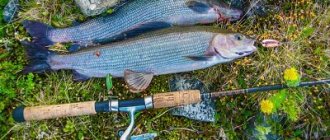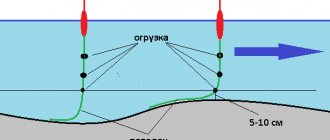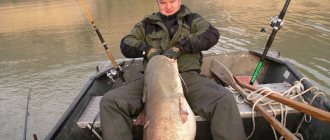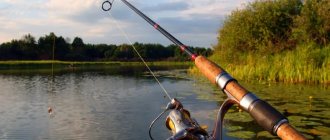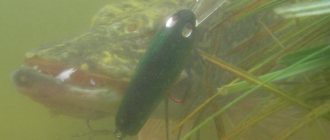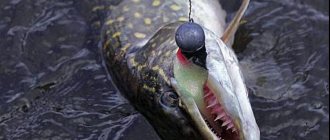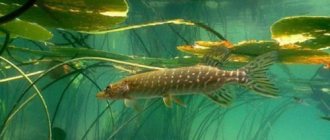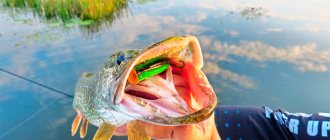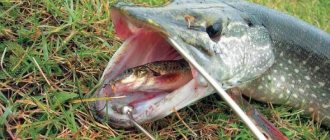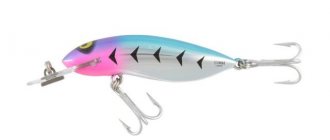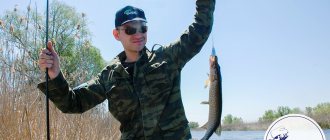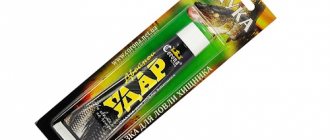The simplest thing is to let go of the spinner and swim behind the boat, driven by the oars.
Large areas of the lakes are not inhabited by fish. Therefore, an angler who is not familiar with the profile of the lake bottom, its deep and shallow places, can waste a lot of his time in vain.
In this case, it is very useful to have a navigation chart that shows underwater slopes, hills and shallows where fish can feed. Using a map, you can rule out many places in advance and focus your attention on the most likely fish locations.
Many predators hunt on the surface at certain times of the day. American perch, pike, salmon and migratory brown trout search for food in shallow water 1 to 3 meters deep. The best way to catch these types of fish is to troll them using lightweight spinners and floating wobblers. When trolled at a minimum speed of 1.5 knots, these artificial lures look natural and attractive. At this speed, large, ultra-light oscillating spoons also work beautifully, lively and seductively, as do wobblers, if they are not lowered to great depths. This type of fishing is called surface trolling.
Fish feeding in the middle layers are difficult to detect. To do this, you need to fish at different depths, lowering the bait to 3, 6 and 9 meters. When the fish grabs one of the baits, the rest can be brought exactly to this depth.
A simple version of this rig can be made by tying a meter-long leash to the fishing line, and passing the fishing line itself through a sliding sinker. This tackle will help keep the bait at the bottom, but the fishing line is subject to wear and tear.
Deep trolling near the bottom is effective for catching pike and other types of fish both with artificial bait and with natural bait. The picture shows one type of equipment for deep trolling. To reduce the risk of getting caught on the bottom, floating wobblers should be used.
In summer, lake fish are often found in open water, where they hunt for fry. Trolling in these waters comes down to finding fish in the pelagic zone. In fact, predators seem to prefer to be in specific water layers, so the only way to catch them is to determine the right depth. The best solution to this problem may be to use several rods designed for different depths. For surface fishing, you can use an oscillating spoon. Install a floating wobbler on the second rod. descending 2 - 4 meters. At a depth of 4 - 6 meters, it is best to use diving and sinking wobblers or spinners with a weighted lead head. In the warm summer months, the fish sometimes go to an even greater depth of 7 - 10 meters. At such depths, only medium-sized sinking wobblers with an elongated blade work.
Using these four types of artificial baits, the lake can be fished to a depth of 10 - 12 meters. If the water is clear, this method becomes even more catchy, since the fish can see the bait from a depth of 15 meters. When biting, the angler detects the depth at which the fish is located. This trolling method can also be used on underwater slopes and shallows by charting the depth and using crankbaits that are lowered to a specific depth.
Trolling Basics
There are several principles of trolling, regardless of which boat it is carried out from: a rowing boat, a motor boat, or even an electric one. The first is to use a rod holder. Firstly. The rod holder should be firmly fixed in the boat, preferably permanently. It must securely hold the rod and at the same time provide the angler with quick access to it at the time of the bite. Simple holders can be made from metal or plastic pipes secured to the boat. Various portable holders are also available for sale. The most practical of these devices is undoubtedly the Down East, which not only meets all the above requirements, but can also be installed on almost all small boats.
Down East example:
It is optimal to steer the boat in a slightly zigzag or curved course. Using two or three rods, this course recreates the natural situation where the bait on one side of the boat swims faster than the bait on the other side of the boat. Turns should be made slowly to prevent the lines from becoming tangled. In this situation, you can use from two to four rods.
The line should be released through a weak cast, or simply release the spool, and then the forward movement of the boat will unwind the line from the reel. When trolling, it is better to use short lines, but they must be long enough to cover the fishing area well. Long fishing lines make it difficult to control the action of the bait. The vibration of the rod tip when retrieving means that the bait is moving in the correct way. In addition, it is better to hook with a short line.
Secondly, trolling with artificial bait from the bottom is that the line released should be 50% longer than the depth at which you are fishing. This length can only be increased if the water is crystal clear and the fish are shy. It's also worth spending some time experimenting with different lures until you find the best one.
Short trolling during the day
Of course, trolling with a three-way rig isn't just for night fishing. With the arrival of summer, it becomes an excellent way to fish in deep areas of reservoirs. On a calm, sunny day, trolling with a short line is often the best option for attracting passive walleye.
In very clear water this method is excellent at depths of 7-8 m, but in shallower areas the boat may spook the fish. I have had success more than once when trolling at the upper edge of the deep-sea edge, which began from a long underwater spit tapering and descending from 6 to 9 m.
During the day I used small lures with inactive action, such as a 9 cm black and silver Original Floater (Rapala). Like other fishing methods, trolling with a short line is not universal, that is, it is not always suitable and not everywhere.
Don't forget that even the best technique will not be productive if you are fishing where there are no walleyes. Since the technique is closely related to the structure of the bottom, catches will be higher if you troll in areas with a high concentration of fish. Fish the right way in the right place and short line trolling will become a regular part of your trolling repertoire.
Deep trolling
The fish spends most of its time at a depth of 5-15 meters or more. Unfortunately, only a few lakes have water clear enough to maintain good visibility at these depths. If you know the depth of the lake or use an echo sounder, the bait can be lowered first to 5 meters, and then, a minute later, to a depth of 10 meters or more. The best way to keep your bait near the bottom at all times and make sure it is moving at the right depth is to attach a sinker to the leader in front of the bait. Previously, a deep trolling device or an American invention called the Bait Walker was used to lower the bait to the bottom. This tackle is very effective when fishing for American bass, trout, pike or pike perch.
A downrigger consists of a spool of wire line, an arrow and a block through which the line passes. Most downriggers are equipped with a rod holder, a depth gauge and a reeling system. The rod used in conjunction with a downrigger should be of medium action and properly installed.
Installation of tackle for trolling pike
Tackle for catching pike by trolling must be durable with a reserve, because in addition to the stubborn resistance of the wobbler itself, which can be very large and with a long blade, the gear is influenced by the current, and most importantly, by the prey, which is also not small. And a large pike knows how to stand up for itself. In addition, it is not particularly uncommon for the bait to catch on the bottom, grass and snags, which even at low boat speeds sometimes leads to line breakage and rod breakage.
Now about the equipment. More detailed information about devices and equipment for trolling can be found in this section of the site. But there are some features in trolling for pike that should be mentioned for the sake of completeness. As you know, metal leashes are also used in pike fishing with a classic spinning rod. In trolling, their role is just as important. But there is always a choice in favor of strength and flexibility, where it is quite difficult to find a compromise. Steel leashes have always been distinguished by no less steel strength, but at the same time by primitive roughness, which negatively affects the performance of the most expensive, playful and catchy wobbler. Kevlar and similar leashes are distinguished by excellent flexibility and at the same time good strength, moreover, they are thin and unnoticeable, like fishing line. But they have one drawback. During numerous fishing trips, which often culminated in the capture of a toothy predator, such leashes eventually lose strength, cut by powerful and sharp pike teeth. This cannot always be determined by eye. And it is better to replace such leashes from time to time. So what should you choose, unwavering strength or stealth and flexibility? It’s up to the fisherman to decide, of course, but the answer suggests itself: it’s better not to be lazy and replace Kevlar leashes after a certain time, but still catch pike, than to fruitlessly drag around a strong but rough tackle, from which the stupidest pikes turn away...
Now about the choice of fishing line. At first glance, there is no alternative to braided cord due to its strength and lack of windage, especially if the bait is more than 50-60 meters away from the boat. And many trollers successfully use braided line. However, one must take into account such a factor as the complete lack of extensibility of the braided cord, which often causes breaks and breakages of the tackle during sudden braking when hooked and grabbed by a trophy pike, which does not always have time to play the friction brake, especially if it is configured incorrectly. Therefore, other fishermen often use a special trolling monofilament line. It also has a significant drawback: during movement and active operation of the wobbler, the line twists into a kind of spring. But this annoying drawback can be corrected if all connections are made using swivels.
Another factor in catching pike by trolling is the ability to deepen the wobbler to the desired level in the water column or near the bottom. Not everyone, even an experienced troller, is able to deliver a wobbler to a depth of more than 3-4 meters, even if this wobbler is designed according to its characteristics for such depth. Moreover, a novice fisherman cannot always cope with such a task. That’s why various deepeners are used, in particular, such as Diving Planers and Downrigger pseudo-winches, which hold the wobbler at the same level. The simplest and most accessible device for delivering bait to the required depth and holding it at this level is the so-called sinker. This is, in fact, a flat sinker that helps the wobbler sink to depth. But there are also more functional sinkers, for example, from the Kuusamo company, which can also serve to set the direction of the bait. And this is very important when several spinning rods are used and baits, deviating from a given direction, can overlap. Sinkers replace the more complex and expensive devices discussed above, at least in river fishing.
To catch pike by trolling, it is better to use baitcasting reels with a line counter, which allows you to track the length of the bait release and even the diving depth. In addition, these are more powerful coils designed for heavy loads.
Trolling with a downrigger
Casting weighted artificial baits allows you to troll them at depths of up to about 10 - 15 meters. For fishing at a depth of 10 - 20 meters, a diving glider is used, fixed at a distance of 2.5 - 4 meters from the bait. These sinkers are used to lower the bait to the desired depth, but when landing fish, the resistance of the sinker, often made of metal or plastic, creates additional stress on the line. Past generations of sports fishermen had to hang heavy lead weights on a fishing line to troll at great depths. Thousands of large pikes. North American trout and salmon were caught using sinkers weighing 3 - 5 kilograms and heavy sea fishing gear. This type of sport fishing was very productive.
A downrigger consists of a spool with wire line, an arrow and a block through which a single-strand or braided line passes. Most of these tackles have a reeling system, a line counter and a rod holder. The sinker is attached to the end of the wire. The mechanism for releasing the line is placed either on the wire or on the sinker itself.
If you use one downrigger to troll several baits, then additional mechanisms are installed higher on the wire to release the fishing line.
These mechanisms hold the line at a distance of 3 to 30 meters from the bait, depending on the depth at which the fish is holding, water clarity and other factors.
The weight of the sinker depends on each individual downrigger. The heaviest sinkers weigh approximately 6 kilograms. They are often shaped like a torpedo with wings.
It is important to note here the importance of an echo sounder in determining the desired depth. It is also useful for identifying predators that frequent specific depths. With this information, you can troll one lure slightly above where the fish are, another below it, and two more directly at the depth where the fish are holding.
The downrigger can be used on boats of any size. The rod is installed either in the holder of the downrigger itself. or next to it. For fishing with a downrigger, special rods are sold that allow you to make a more powerful hook when biting. Typically, such rods are equipped with a baitcasting reel with a relatively thin line, which can, however, withstand the trolling load at a speed of 3 - 4 knots.
The line release mechanism must be carefully adjusted. It can be made in the form of a clamp or spring, which, when bitten, releases the fishing line so that the angler can catch the fish using the rod. When the water warms up, predators move to those water layers whose temperature suits them more. Sometimes they go to depths of 30 - 50 meters. A temperature indicator attached to the downrigger cord can show you what the temperature is where the bait is located.
Choosing a place to catch pike by trolling
Pike fishing by trolling is most common on large lakes and reservoirs, as it requires large spaces and areas for swimming through catching points. This, of course, is primarily due to the method of wiring wobblers, which is not manual wiring, but pulling the bait behind a boat with a motor at low speed. And it is desirable that the motor be from the category of motors specifically designed for trolling.
If we talk about the simplest methods of catching pike by trolling, then it will be fishing on rivers and reservoir channels with a straight channel, without many winding turns. This is an ideal option for beginner trollers. There are quite a few such places in the flood zone of the Cheboksary hydroelectric power station, where the channels between the islands often resemble rivers with smooth banks. There are no sharp jumps or changes in depth, since before the flooding there were meadows and copses. And stream beds and ravines, which have become underwater grooves and longitudinal holes, can now be called catching points for trolling pike. It is better, of course, to go through all these areas of the upcoming fishing in advance on a motor, measuring the bottom, finding underwater channels and marking them in the navigator. Here there are even sections of channels, where a longitudinal pit stretches along the channel, without ending, but only changing direction, either from the center of the channel to the left bank, or to the right.
Knowing the depth and boundary of the edge, you can select a wobbler with the required depth so that it moves along the upper level of the edge, where there is the greatest chance of encountering a pike lying in ambush. The lower edge of the fall into the pit will most likely not give bites. Bivalve mollusks usually do not live there, which means that roach, silver bream and bream, which serve as prey for pike, do not live there. At the upper level of the edge, life usually flourishes in the form of vegetation, mollusks and a nursery in the form of fry and small fish, as well as zooplankton, which serves as food for these fish.
On flat, straight sections of channels and rivers, trolling for pike will be more effective if in such places, in addition to changes in depth, there are any obstacles in the form of drifts and islands. These places will be promising for pike trolling. Fishing in not very deep places along the coastal vegetation can also be quite successful, where not only medium-sized grass pikes, but also quite weighty seasoned pikes are often found. But they come here more often in the morning dawns, especially in the summer heat, when the clutches of a large predator often occur on the border between night and early morning. The only negative is that there are often snags on the grass and bottom. Therefore, wobblers should be selected for such places with minimal depth.
The most promising and even the most promising are the bends of the river or the channels of the reservoir. And here you need to be prepared for the fact that these places can turn out to be both catchy and destructive for bait.
Wobblers will most likely cling to snags and driftwood, which usually accumulate near the shore, where the stream of current coming out from around the bend hits, even if it is not strong. Anyway, in the spring, large meltwater regularly brings bushes, sticks and real trees here, which, settling to the bottom, create a real jungle of snags. All kinds of fish live here and there are especially many predators in such places, but, as already mentioned, snags are inevitable here. And the only way out is to masterfully bait on the border of snags and a clean riverbed. And an experienced fisherman will certainly find success here.
Areas with a deep channel in the middle are also successful. The wobbler here should be held so that it seems to bounce off the upper edge of the edge, touching it and moving to the side. These zigzag movements are sure to irritate the pike and force it to attack the bait.
In the vastness of reservoirs, it is easier to use free search tactics. Often this tactic, close to the heart of a simple lazy fisherman, works perfectly, especially when there is a lot of gasoline in stock and there is a desire to simply walk along the man-made sea, when the weather is calm and there are no waves. But purposeful trollers will not just walk along the reservoir, despite the picturesque landscapes of the shores and the blue distances. They first make a reconnaissance of the water area and the bottom, noting in the navigator spits, holes and edges on the border of the holes and shallow spits. And already using these marks, indicating promising places, the wobblers are deployed. Sometimes you can navigate by various water navigation signs for navigation, where there are edge buoys and buoys in shallow waters, and various leading signs. All this can also be used for your navigation when fishing, when the expanses of the reservoir are so vast that finding a certain place in them can be difficult.
Electronic equipment
The easiest way to measure depth is to lower a rope with a sinker at the end into the water. A small plastic mark is attached to each meter of this rope, and when the sinker reaches the bottom, all that remains is to count the number of these marks. However, this lengthy process takes a lot of time if used frequently.
Electronic depth measuring equipment has made sport fishing and especially trolling a fun and effective activity. There are several different types of echo sounders: backlit, LCD, graphic and color. An illuminated echo sounder is the cheapest and gives a very clear picture of the depths and structure of the bottom - rocky, sandy or muddy. Their more complex variations also show concentrations of fish, individual individuals, and give sound signals when a fish is detected or a sandbank is approaching. All this information is displayed on the screen in the form of light signals.
A graphic recorder records all the information on a roll of paper. This type of echo sounder provides information about depth, bottom structure, shallows, sunken tree trunks, small fish, predators, hot spots and currents. Video echo sounders use more advanced technology. They provide the same information, but in color. Other equipment that can be installed to assist the angler include a sensor to measure water temperature and a device to indicate trolling speed.
Wobblers for trolling for pike
For catching pike by trolling, the largest wobblers are selected. Their size can vary between 8-20 centimeters. It is clear that when choosing a large wobbler, the fisherman must focus on large pike, and accordingly, the fishing spots must be selected to suit the living conditions of the seasoned predator. It will be funny to see a disproportionately large wobbler in grassy shallow water near the shore. The bait will most likely scare away all the small grass pikes in the area. To catch small pike, you can choose baits measuring 4-8 cm.
Pike rarely attacks fish and takes bait on the surface of the water. More often it hunts in mid-water and near the bottom. Therefore, there is no need to choose wobblers with a small depth. This is the hunting zone for asp and chub. And for pike, you should select baits with depth, ranging from two meters to depths of 7-8 meters.
To catch pike by trolling, it is better to select lures with natural colors that resemble the colors of living fish. It is better if the color scheme of such wobblers includes green and red colors, as well as their shades. If the weather is gloomy or fishing takes place at dusk or early dawn, then the same indicated colors can be in the form of so-called acid colors, which are so bright that it seems that they are illuminated from the inside by a light bulb.
Good wobblers for pike for trolling must have a sound background, as well as high-frequency vibrations. This is achieved by rattles, which have relatively expensive baits, and the shape of a wobbler. Speaking of rattles, it should be noted that budget baits and Chinese copies of successful analogues often do not have a background sound. If we look at the shape of a productive wobbler, it will most likely resemble a live fish. These are the most common representatives of the underwater world, which serve as prey for pike. These include: roach, bleak, perch, gudgeon, small crucian carp, roach, dace. The bait must also have a wide, bright action and at the very initial speed of the retrieve, otherwise the pike will simply bypass the bait with its attention. An example of an effective classic wobbler for pike is the Deep Tail Dancer bait from the well-known manufacturing company Rapala.
For spring trolling for pike, wobblers from the category of sinking baits or suspenders are most suitable, which is due to the peculiarities of this period, when pike stays at depth. A little time will pass and when the water warms up, the predator will begin to enter the coastal shallows and spits. Here you can use wobblers with a slight depth. The same thing happens in the summer, when the predator stays near the grass. At this time, despite the usual level for pike at half-water and near the bottom, predators often stand under water lily leaves or under other vegetation. To catch pike in such conditions, you can also use floating wobblers, passing the bait along a strip of grass.
With the onset of autumn cold weather, deep-sea large wobblers will be needed again.
Fish as objects of sport fishing
It can be said that North American anglers are the happiest sportsmen in the world. Nowhere else can you find so many species of commercial fish and in such quantities, both in freshwater bodies and in the seas. Although pollution, acid rain and uncontrolled human activity have tainted once-life-rich bodies of water, most river and lake systems remain clean enough to support healthy fish populations. The combined forces of serious fishermen and modern environmentalists have saved many bodies of water from certain destruction.
